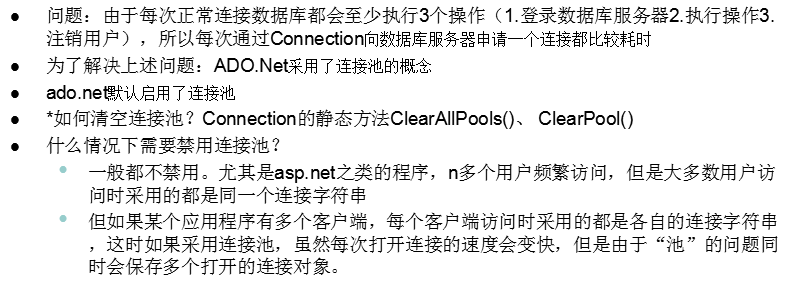1、

2、

3、示例:在一百次循环中,执行数据库连接的打开和关闭,使用stopwatch查看所用的时间。


using System; using System.Collections.Generic; using System.ComponentModel; using System.Data; using System.Drawing; using System.Linq; using System.Text; using System.Windows.Forms; using System.Data.SqlClient; using System.Diagnostics; namespace WindowsFormsApplication1 { public partial class Form1 : Form { public Form1() { InitializeComponent(); } private void button1_Click(object sender, EventArgs e) { Stopwatch watch = new Stopwatch(); watch.Start(); for (int i = 0; i < 100; i++) { SqlConnection conn = new SqlConnection("server=.;database=dbtest;uid=sa;pwd=123"); conn.Open(); conn.Close(); conn.Dispose(); } watch.Stop(); label1.Text = watch.ElapsedMilliseconds.ToString(); } private void button2_Click(object sender, EventArgs e) { Stopwatch watch = new Stopwatch(); watch.Start(); for (int i = 0; i < 100; i++) { SqlConnection conn = new SqlConnection("server=.;database=dbtest;uid=sa;pwd=123;Pooling=false"); conn.Open(); conn.Close(); conn.Dispose(); } watch.Stop(); label2.Text = watch.ElapsedMilliseconds.ToString(); } } }

结论:
1.在ADO.NET中的每个应用程序都维护一个连接对象池,每次使用时不会新建对象,而是先从池中获取,得到后直接使用,
如果没有则新建,减少了每次新建的时间
2.在内存中开辟一个集合空间,用于存储空闲的对象,如果每次需要对象时,先从集合中获取,如果获取不到在新建。
3.对象池:提高执行效率
4说明:
(1)两次连接所使用的字符串必须一样
(2)打开使用,使用完成后close()则将连接对象放到连接池中;当使用连接对象时,去连接池中找,有可用的则拿过来用。
(3)如果某个连接对象在使用中没有关闭,又需要使用连接对象,则会重新创建一个新的连接对象,因为此时没有空闲的连接对象。
(4)可以设置备用连接对象数;在连接字符串中设置。
(5)close并不是真的关闭连接,而是将连接对象放入连接池中。
